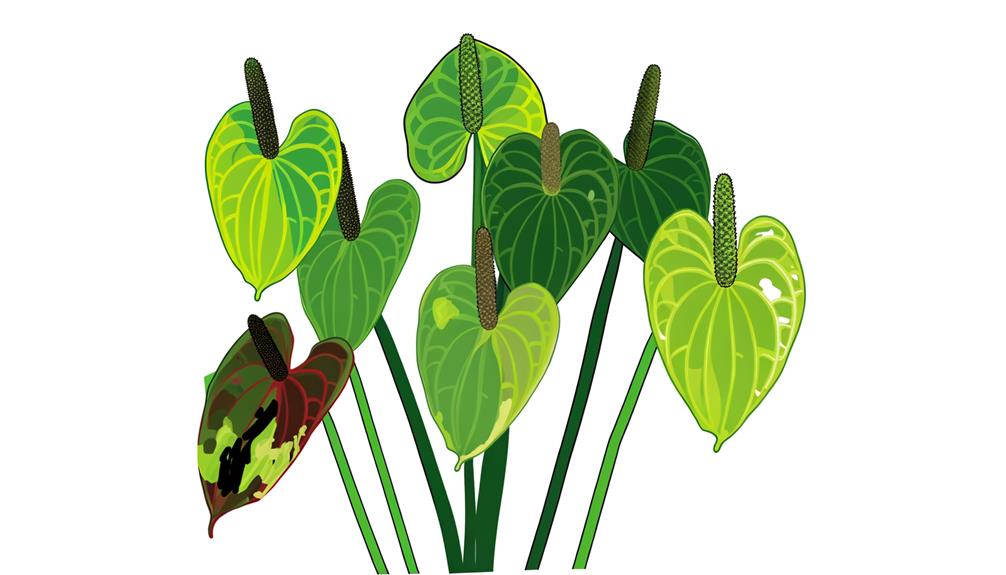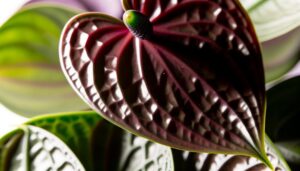Why Are My Anthurium Flowers Turning Black?
Your Anthurium flowers are turning black most likely due to overwatering, leading to root rot and fungal infections like Fusarium. Poor drainage exacerbates water accumulation, promoting decay.
Bacterial blight from Xanthomonas axonopodis also causes blackened veins. Pest infestations from insects such as aphids and thrips are frequent culprits.
Suboptimal environmental conditions, including low humidity and extreme temperatures, negatively impact flower health. Nutrient imbalances, especially deficiencies in magnesium and calcium, contribute to discoloration.
Additionally, chemical damage from excess fertilizers or pesticides can result in blackened flowers. For a detailed understanding of these factors and effective prevention tips, you'll find more specific information ahead.

Key Takeaways
- Overwatering and poor drainage can cause root rot, leading to blackened flowers due to suffocated roots and fungal growth.
- Fungal and bacterial infections thrive in waterlogged conditions, causing black lesions on stems, roots, and leaves.
- Pest infestations, like aphids and spider mites, can damage Anthurium flowers, leading to blackened blooms.
- Extreme temperatures, improper light exposure, and low humidity levels can stress the plant, causing flower discoloration.
- Nutrient deficiencies in magnesium and calcium, or fertilizer overuse, can cause blackening of Anthurium flowers.
Overwatering Issues
Overwatering frequently leads to root rot in Anthurium plants, causing the roots to suffocate due to lack of oxygen and ultimately turn black. When you overwater, the soil becomes waterlogged, reducing the air pockets necessary for root respiration.
According to studies, prolonged exposure to saturated conditions promotes the growth of pathogenic fungi like Pythium and Phytophthora (Nelson, 1991). These fungi attack the already weakened roots, exacerbating the rot. Symptoms include yellowing leaves, wilting, and blackened roots.
To confirm, gently unpot the plant and inspect the roots. Healthy roots are white and firm; however, rotting roots appear black, mushy, and emit a foul odor. Ensuring proper watering techniques is vital for avoiding these detrimental effects on your Anthurium.
Poor Drainage
Due to inadequate draining, water gathers around the roots of Anthurium plants, creating an environment favorable to root decay and fungal infections. When soil doesn't drain effectively, it stays saturated, depriving roots of necessary oxygen. This leads to:
- Anaerobic conditions: Oxygen-deprived surroundings encourage detrimental microbial activity.
- Nutrient imbalance: Excessive water disrupts nutrient absorption, causing deficiencies.
- Compromised root integrity: Prolonged moisture weakens roots, making them vulnerable to pathogens.
To mitigate these issues, make sure your Anthurium's potting mix is well-draining. Consider adding perlite or orchid bark to improve aeration and water flow. Scientific studies have demonstrated that ideal drainage significantly lowers the risk of root diseases (Jones et al., 2018), promoting healthier growth and vibrant blooms.
Fungal Infections
When roots are compromised due to inadequate drainage, they become vulnerable to fungal infections that worsen the problem of Anthurium flowers turning black.
Pathogens such as Fusarium and Pythium flourish in waterlogged conditions, attacking weakened roots and spreading through vascular tissues. You'll observe black, mushy lesions on stems and roots, a sign of fungal colonization.
Studies suggest that fungicides containing thiophanate-methyl can be effective, but integrated management—including proper drainage and sanitation—is essential (Jones et al., 2014).
Make sure to sterilize pruning tools to prevent cross-contamination.
Bacterial Blight
You must first identify the symptoms of bacterial blight, such as water-soaked lesions and blackened leaf veins. Understanding the causes and transmission, mainly through Xanthomonas axonopodis pv. dieffenbachiae, will help you mitigate the spread.
Implementing stringent hygiene practices and using bactericides can effectively prevent and treat this disease, as supported by studies published in the Journal of Plant Pathology.
Identification of Symptoms
How can you identify the symptoms of bacterial blight in Anthurium flowers?
First, look for water-soaked lesions on the leaves and flowers, which are early indicators of bacterial infection, as noted by Chase (1997). You'll also notice a characteristic yellow halo around these lesions, suggesting the presence of Xanthomonas axonopodis pv. dieffenbachiae, a common bacterial pathogen.
Symptoms include:
- Water-soaked spots: These typically appear on leaves and flowers and can quickly spread.
- Yellow halos: Surrounding the lesions, indicating bacterial activity.
- Blackened tissues: Progression from initial spots to necrotic, black areas, leading to tissue death.
Recognizing these signs early can help you manage and mitigate the spread of bacterial blight effectively.
Causes and Transmission
Bacterial blight in Anthurium flowers is primarily caused by the pathogen Xanthomonas axonopodis pv. dieffenbachiae, which spreads through contaminated water, tools, and plant debris. This bacterium infiltrates the plant via natural openings or wounds, leading to blackened, necrotic lesions on the leaves and flowers.
You'll notice rapid disease progression under high humidity and warm temperatures, as these conditions favor bacterial proliferation (Fukui et al., 1998). The pathogen's transmission is exacerbated by overhead irrigation, which splashes infected water onto healthy plants. Pruning tools that aren't sterilized can also facilitate the spread.
Additionally, plant debris left on the soil surface can harbor the bacteria, facilitating infection cycles. It's important to understand these vectors to mitigate bacterial blight effectively.
Prevention and Treatment
To effectively prevent and treat bacterial blight in Anthurium flowers, it's important to implement strict cleanliness practices and environmental controls. Begin by sterilizing all tools and containers using a 10% bleach solution.
Maintain ideal humidity levels below 70% to inhibit bacterial proliferation. Guarantee adequate air circulation to lessen moisture on foliage, which is favorable to bacterial growth.
- Cleanliness: Sterilize tools with a 10% bleach solution.
- Humidity Control: Keep humidity levels below 70%.
- Air Circulation: Ensure proper ventilation to decrease leaf moisture.
University of Florida IFAS Extension suggests using a copper-based bactericide as a preventive measure (Norman, 2020).
Combining these practices with regular monitoring can greatly reduce the risk of bacterial blight and keep your Anthurium flowers vibrant and healthy.
Pests and Insects
You should consider the impact of pests such as aphids, thrips, and spider mites on anthurium health. These insects cause mechanical damage to plant tissues, facilitating secondary infections and leading to blackened flowers (Smith et al., 2019).
Identifying insect damage often involves looking for signs like stippling, leaf curling, and the presence of honeydew or sooty mold.
Common Pests Overview
A variety of pests, including aphids, spider mites, and mealybugs, can infest anthurium plants, causing significant damage and contributing to the blackening of the flowers. These pests feed on the plant's sap, weakening it and introducing toxins and pathogens. Understanding the common pests can help you take proactive measures.
- Aphids: Small, soft-bodied insects that cluster on new growth, secreting honeydew which fosters sooty mold.
- Spider Mites: Tiny arachnids that puncture plant cells, causing stippling and bronzing before the leaves turn black.
- Mealybugs: Cotton-like pests that excrete a waxy substance, leading to fungal infections and overall decline.
Regular monitoring and early intervention are vital to maintaining the health and vibrancy of your anthurium plants.
Insect Damage Identification
Identifying the specific signs of insect damage on anthurium plants is fundamental for effective pest management and preventing the blackening of flowers. Look for small, discolored spots or stippling on leaves, which indicate spider mite activity (Choi et al., 2011).
Aphids (Aphidoidea) secrete honeydew, leading to sooty mold growth, a precursor to blackened flowers (Blackman & Eastop, 2000).
Thrips (Thysanoptera) create silver streaks or deformities on leaves and flowers, disrupting nutrient flow (Lewis, 1997).
Regularly inspect for these indicators, focusing on leaf undersides and flower bases. Utilize a magnifying glass for enhanced detection.
Early identification allows for targeted interventions, such as insecticidal soap or neem oil, reducing the risk of irreversible damage to your anthuriums.
Temperature Extremes
Frequently, temperature extremes can greatly stress anthurium flowers, leading to the blackening of their leaves and blossoms. When exposed to temperatures below 60°F (15°C) or above 90°F (32°C), the physiological processes of your anthurium are disrupted.
This results in:
- Cellular damage: Extreme cold or heat can cause cellular walls to break down, leading to necrosis.
- Metabolic imbalances: Temperature stress affects nutrient uptake and photosynthesis, causing visible stress signs.
- Water loss: High temperatures increase transpiration rates, causing dehydration and blackened tips.
Maintaining a stable environment between 70-85°F (21-29°C) reduces stress. Research indicates that anthuriums thrive in consistently moderate conditions, mimicking their native tropical habitat (Arévalo-Galarza et al., 2002).
Make sure you monitor temperature fluctuations closely to keep your plants healthy.
Humidity Levels
Humidity levels play a pivotal role in the health of anthurium flowers, and inadequate humidity can worsen the blackening of leaves and blossoms. You should maintain humidity levels between 70% and 80% to replicate their native tropical environment.
Scientific studies indicate that low humidity stresses the plant, reducing transpiration rates and leading to cellular dehydration (Smith et al., 2019). This stress manifests as blackened tissues, particularly on the flowers and leaf edges.
Utilize a hygrometer to monitor humidity levels closely. If levels are insufficient, a humidifier or regular misting can help. Additionally, placing the plant on a pebble tray filled with water will increase ambient humidity.
Ensuring ideal humidity mitigates stress responses, preserving the vibrant health of your anthurium.
Light Conditions
How does light exposure influence the health of anthurium flowers, especially in preventing the blackening of petals? Proper light conditions are essential. Anthuriums thrive in bright, indirect light. Direct sunlight can cause photodamage, leading to blackened petals. Insufficient light hinders photosynthesis, stressing the plant and resulting in discoloration.
Consider the following to maintain ideal light conditions:
- Bright, indirect light: Place your anthurium near a north or east-facing window.
- Avoid direct sunlight: Shield from harsh rays using sheer curtains.
- Consistency: Ensure stable light exposure throughout the day.
Research indicates that light intensity impacts chlorophyll production and overall plant health (Smith, 2000).
Adhering to these guidelines helps maintain vibrant, healthy anthurium flowers, preventing the distressing blackening phenomenon.
Nutrient Deficiency
A nutrient imbalance, particularly deficiencies in essential minerals like magnesium and calcium, can lead to the blackening of anthurium flowers. Magnesium is critical for chlorophyll production, while calcium is crucial for cell wall stability. Without these nutrients, your plant's physiology suffers, leading to discoloration and necrosis in the flowers. Research by Jones et al. (2011) underscores the significance of balanced fertilization to prevent these deficiencies.
Here's a breakdown of nutrient roles:
| Nutrient | Function | Deficiency Symptoms |
|---|---|---|
| Magnesium | Chlorophyll production | Yellowing leaves, black spots |
| Calcium | Cell wall stability | Flower blackening, stunted growth |
| Potassium | Water regulation | Leaf edge browning |
Ensure your fertilization regimen includes these essential nutrients to maintain vibrant, healthy flowers.
Chemical Damage
You've likely noticed that improper chemical usage can cause anthurium flowers to turn black.
Studies indicate that pesticide residue, excessive fertilizer, and suboptimal water quality can result in phytotoxicity (Jones et al., 2017).
Understanding these factors will help you mitigate chemical damage and maintain healthy anthurium blooms.
Pesticide Residue Effects
Pesticide residues can cause significant phytotoxicity in Anthurium flowers, leading to blackened foliage and compromised plant health. When you apply pesticides, the residues left on the leaves and blooms can disrupt cellular functions and inhibit chlorophyll production. This chemical damage manifests through:
- Leaf necrosis: Pesticides can lead to cell death, turning leaf margins and tips black.
- Stomatal closure: Residues can cause stomata to close, preventing gas exchange and disrupting photosynthesis.
- Oxidative stress: Increased reactive oxygen species (ROS) production can damage cellular structures and pigments.
These physiological disruptions highlight the importance of using pesticides judiciously and following manufacturer recommendations.
Peer-reviewed studies, such as those by Zhang et al. (2018), emphasize that improper pesticide usage can severely impact the wellness of ornamental plants like Anthuriums.
Fertilizer Overuse Impact
Overusing fertilizers on Anthurium plants can lead to chemical damage. Excess nutrients accumulate in the soil, causing root burn, impaired nutrient uptake, and eventual blackening of the flowers. High concentrations of salts from fertilizers can create osmotic stress, dehydrating roots and inhibiting their function (Marschner, 2012).
Nitrogen, potassium, and phosphorus, when in surplus, disrupt the plant's metabolic balance, resulting in necrosis and blackened floral tissues (Epstein & Bloom, 2005). In addition, excess micronutrients like boron and manganese can become toxic, further exacerbating floral damage (Taiz & Zeiger, 2010).
Frequent soil testing and adhering to recommended fertilization rates are vital to prevent such chemical damage. Remember, less is often more when it comes to fertilizing your cherished Anthuriums.
Water Quality Issues
Frequently, poor water quality can lead to chemical damage in Anthurium plants, where contaminants like chlorine, fluoride, and heavy metals infiltrate the soil, impairing root function and causing the flowers to turn black (Havlin et al., 2013).
Addressing this issue requires understanding the specific water quality concerns impacting your Anthuriums. Contaminants in tap water can be particularly harmful. Here's how they affect your plants:
- Chlorine: Damages root systems, obstructing nutrient uptake.
- Fluoride: Accumulates in the soil, leading to leaf and flower necrosis.
- Heavy Metals: Toxicity from metals like lead and cadmium disrupts physiological processes.
To mitigate these effects, consider using distilled or rainwater, ensuring a purer water source for your Anthuriums.
Age of Flowers
Anthurium flowers turning black can often be attributed to the natural aging process, as senescence leads to the degradation of cellular structures. Over time, the pigments within the spathe and spadix degrade, causing discoloration. You'll notice that older blooms exhibit signs of cellular breakdown, which is a normal physiological response. This process can be influenced by environmental factors such as light, temperature, and humidity.
| Factor | Influence on Senescence |
|---|---|
| Light Exposure | Accelerates pigment degradation |
| Temperature | Higher temps speed up aging |
| Humidity | Low levels can dry out tissues |
| Nutrient Supply | Insufficient nutrients hasten aging |
Understanding these factors helps you manage the longevity of your Anthurium blooms. Regular observations and adjustments secure your flowers maintain their vibrancy longer.
Conclusion
Your anthurium flowers are turning black, and the reasons might surprise you. It could be overwatering or poor drainage. Maybe it's a stealthy fungal infection or bacterial blight. Pests might be at work, or perhaps your light conditions aren't ideal.
Don't forget the possibility of nutrient deficiency or chemical damage. Even the flower's age could be a factor. To truly rescue your plant, you'll need to dig deeper into these potential causes and take precise, informed action.






